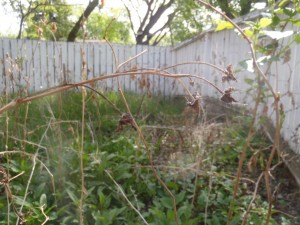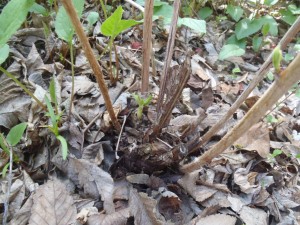I’m writing about this because I know next to nothing about plants, or how they germinate and grow and proliferate. Really. Almost nothing. This week I learned a few simple guidelines for maintaining raspberry bushes that made a mark on my neophyte mind.
When we moved into our house about a year ago we inherited no less than three raspberry stands. I’m not sure of the variety, but based on descriptions I’ve read I would guess they are Boyne raspberries.
Raspberries grow on stalks called canes. Over the winter I often pondered the canes standing in my backyard. Were they dead? Dormant? Would they produce fruit next year? Did I need to do anything to care for them?
Whatever the variety of my raspberries, they are definitely floricanes. This means that they produce fruit only on the canes that grew last year. In other words, a cane grew from the ground last summer, went dormant over the winter, and will produce fruit this year. Hopefully, while that cane is producing fruit this year, another cane will be growing right beside it that will be able to fruit next summer. After a floricane stalk produces fruit it dies with the frost.

I can tell my berries are floricanes because the canes that produced fruit last year are now dead. To identify last year’s fruiting canes, I look for the star-shaped leaves and withered receptacles where the raspberries once were (blurry photo at left). Last year’s fruiting canes also have a pale, parched colour and no leaves, while this year’s fruiting canes are a bit more brown and roan coloured, and at this time of year are producing leaves.
I believe you can avoid the entire ordeal of figuring out which canes are dead and which are live by pruning right after the plants produce fruit in late summer. However, the Alberta Agriculture website says that it is beneficial to leave the dead canes standing over the winter as they protect the dormant canes, like a snow fence. I’m sure it doesn’t matter either way.

Once I’ve identified a dead cane, I follow it to the ground. Since this is an old raspberry patch, there’s a small conglomerate of cane stumps where almost a decade’s worth of fruiting canes were cut off. This is called the crown of the plant. Sure enough there is always another cane extending from the crown, a cane that grew last year, and will therefore fruit this year.
Besides removing the dead canes at the crown, I also cut back a few of the live canes that seemed to have dead tips, and staked up a couple particularly floppy ones.
In addition to floricanes there are primocane raspberries, sometimes called everbearing raspberries. Everbearing raspberries produce fruit on canes that have grown that same year, but only on the very tip of the cane. The plants go dormant over the winter, and the following spring they fruit again, this time lower down the cane. Though primocanes were designed to lengthen the harvest period in this manner, fruit yield is actually higher if you prune the canes down after harvesting the first fruit from the tip of the cane.
That’s everything that I know about growing raspberries. I’m much more adept at eating, fermenting, and drinking them. More on that later in the year.
Pruning Raspberries: Review Questions
- What do we call the stalks on which raspberries grow?
- What is the crown of the raspberry plant? Where is it located?
- What are the differences between floricane and primocane raspberries?
- (Bonus Question) What is the German word for “raspberry”? What does it mean, and why do you suppose the plant was given this name? The answer is buried in this post.